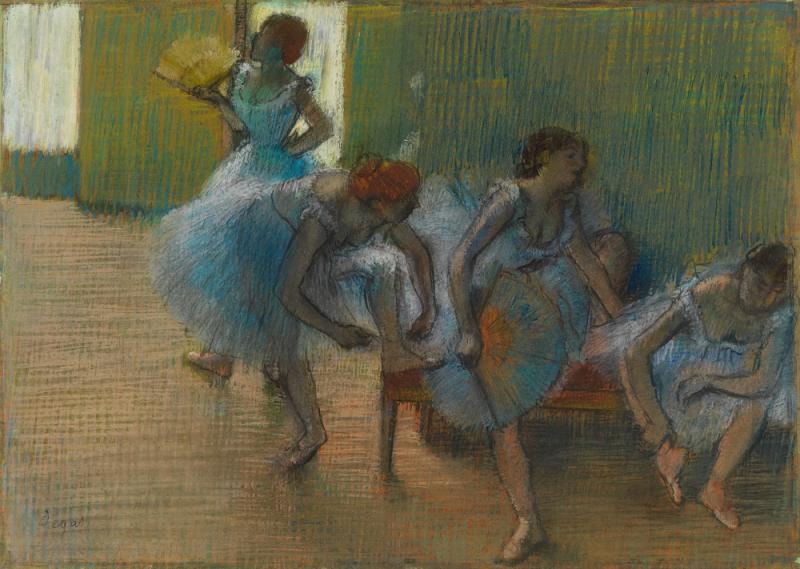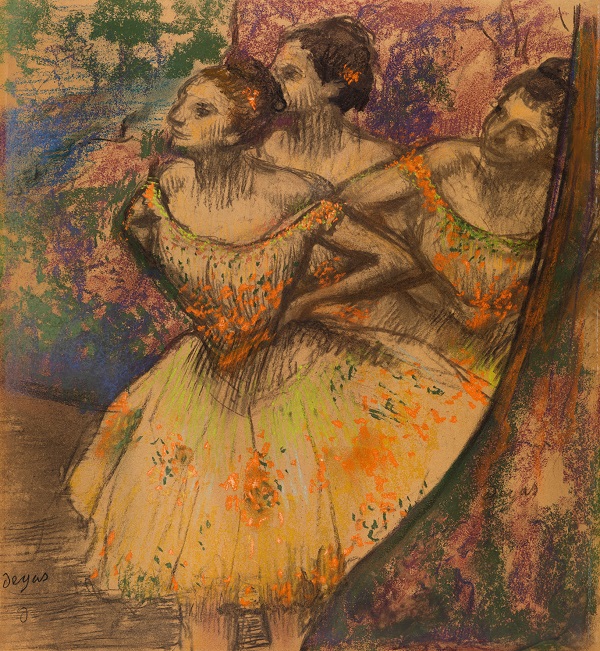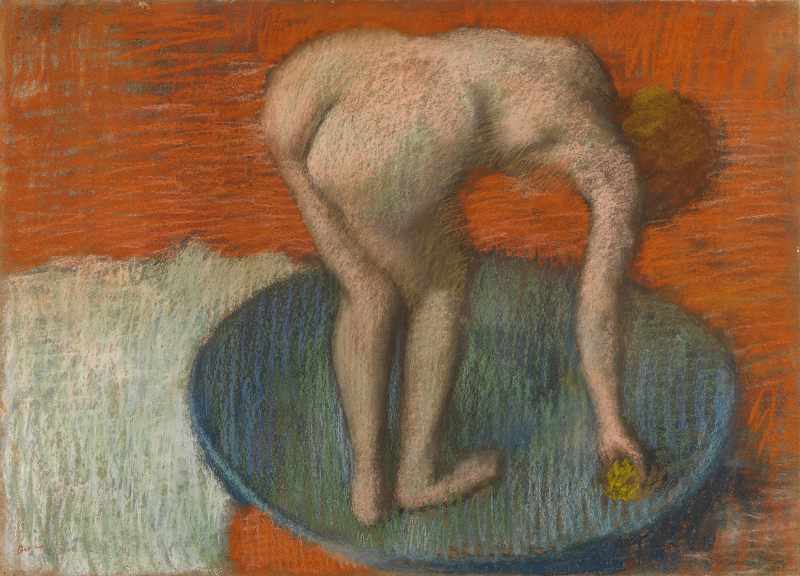Drawn in Colour: Degas from the Burrell Collection review - guilty pleasures at the National Gallery | reviews, news & interviews
Drawn in Colour: Degas from the Burrell Collection review - guilty pleasures at the National Gallery
Drawn in Colour: Degas from the Burrell Collection review - guilty pleasures at the National Gallery
How pastel became a truly modern medium

If only a modest fuss is being made about the rare and prestigious loan currently residing in Trafalgar Square, it could be that the National Gallery is keen to forget the role of its former director, Dr Nicholas Penny, in a row about art transportation that centred on the very collection to which these objects belong.
In an age where art is habitually flown around the world, with one temporary exhibition following hot on the heels of another, the very real risks of art transportation are glossed over by general consent. And so when in 2013, Glasgow City Council applied successfully to the Scottish Parliament to overturn the terms of the Burrell bequest, we caught a rare glimpse of a topic usually kept well and truly behind the scenes. Burrell stipulated that the collection, which includes art, ceramics, furniture and textiles, must never be loaned overseas, and considered especially fragile items like pastel drawings too delicate to travel even within the UK. Feathers were ruffled when none other than Nicholas Penny gave evidence in defence of the travel ban, arguing unfashionably that it should be upheld, and that in his 27 years of museum work, he knew of “10 major accidents in transported art”.
 That the pastels are here in London (with a couple having only recently returned from trips to Australia and the USA) is, according to the Gallery, thanks to improved methods of transporting works on paper, a particular challenge, you might imagine, in the case of the Degas pastels. Degas was a tireless innovator, and as the show’s curator points out, experimental techniques usually equate to unstable artworks. Not in this case apparently: Degas developed his own technique, applying layer upon layer, his special fixative applied between each one to secure pastel to slippery tracing paper. Into these thick accretions of chalk and pigment, he scratched lines that appear as striations or hatching, marks that somehow translate into the play of light across the floor, in Dancers on a Bench, about 1898 (main picture), and elsewhere to the semi-darkness that veils a theatre audience.
That the pastels are here in London (with a couple having only recently returned from trips to Australia and the USA) is, according to the Gallery, thanks to improved methods of transporting works on paper, a particular challenge, you might imagine, in the case of the Degas pastels. Degas was a tireless innovator, and as the show’s curator points out, experimental techniques usually equate to unstable artworks. Not in this case apparently: Degas developed his own technique, applying layer upon layer, his special fixative applied between each one to secure pastel to slippery tracing paper. Into these thick accretions of chalk and pigment, he scratched lines that appear as striations or hatching, marks that somehow translate into the play of light across the floor, in Dancers on a Bench, about 1898 (main picture), and elsewhere to the semi-darkness that veils a theatre audience.
And yet despite the sheer density of pigment on support, whole areas are left bare. The tutus in Three Dancers, about 1900-05 (pictured above right), are transformed by little more than the power of suggestion from brown paper to fluorescent orange and green, applied in economical but sharp hits of colour, made by wetting the pastel stick to produce a solid slash of pigment.
Beautifully displayed in the National Gallery’s new, and surprisingly acceptable subterranean exhibition space, a really perceptive hang makes the most of this opportunity to see so many of these pastels together. Interspersed with a small but instructive selection of oil paintings, you can start to understand what it was that Degas loved particularly about pastel, a medium that, for him, allowed colour and line to achieve a rare parity. Sometimes it is the medium itself that seems to be the subject of the picture, and in one canvas, the effects of pastel are explored in oil paint. While pastel would become Degas’s medium of choice, oil paint, photography, monotype and sculpture all feature in his oeuvre, the different approaches informing each other in a way that stands out as notably modern. Degas’s modernity is perhaps highlighted most interestingly here in terms of his approach to materials, and yet the subject matter itself poses its own, in some ways more nuanced questions. His depictions of skilled, physically strong, working women, from laundresses to ballet dancers are locked into tension with his bathers, which draw out the ambiguities and darker aspects of his treatment of women.
While pastel would become Degas’s medium of choice, oil paint, photography, monotype and sculpture all feature in his oeuvre, the different approaches informing each other in a way that stands out as notably modern. Degas’s modernity is perhaps highlighted most interestingly here in terms of his approach to materials, and yet the subject matter itself poses its own, in some ways more nuanced questions. His depictions of skilled, physically strong, working women, from laundresses to ballet dancers are locked into tension with his bathers, which draw out the ambiguities and darker aspects of his treatment of women.
We will never know who these women are – bourgeois wives and daughters, or prostitutes – and yet of all Degas’s depictions of women they are simultaneously the most frank and the most mysterious, and probably the most troubling. Seen from behind as she bends over to reach her feet, one woman is forever constrained by the dimensions of the canvas (pictured above: Woman in a Tub, about 1896-1901), while the reclining figure in After the Bath, about 1896, is forced into a surely painful, and unnatural posture. Often faceless, their bodies displayed, apparently unknowingly, in the most undignified ways, the pleasure of looking at the bathers is an uncomfortable one, made more so by the knowledge that Burrell may well be spinning in his grave.
- Drawn in Colour: Degas from the Burrell Collection at the National Gallery until 30 April 2018
- Read more visual arts reviews on theartsdesk
rating
Explore topics
Share this article
more Visual arts
 Stephen review - a breathtakingly good first feature by a multi-media artist
Melanie Manchot's debut is strikingly intelligent and compelling
Stephen review - a breathtakingly good first feature by a multi-media artist
Melanie Manchot's debut is strikingly intelligent and compelling
 Fantastic Machine review - photography's story from one camera to 45 billion
Love it or hate it, the photographic image has ensnared us all
Fantastic Machine review - photography's story from one camera to 45 billion
Love it or hate it, the photographic image has ensnared us all
 Yinka Shonibare: Suspended States, Serpentine Gallery review - pure delight
Weighty subject matter treated with the lightest of touch
Yinka Shonibare: Suspended States, Serpentine Gallery review - pure delight
Weighty subject matter treated with the lightest of touch
 Jane Harris: Ellipse, Frac Nouvelle-Aquitaine MÉCA, Bordeaux review - ovals to the fore
Persistence and conviction in the works of the late English painter
Jane Harris: Ellipse, Frac Nouvelle-Aquitaine MÉCA, Bordeaux review - ovals to the fore
Persistence and conviction in the works of the late English painter
 Sargent and Fashion, Tate Britain review - portraiture as a performance
London’s elite posing dressed up to the nines
Sargent and Fashion, Tate Britain review - portraiture as a performance
London’s elite posing dressed up to the nines
 Zineb Sedira: Dreams Have No Titles, Whitechapel Gallery review - a disorientating mix of fact and fiction
An exhibition that begs the question 'What and where is home?'
Zineb Sedira: Dreams Have No Titles, Whitechapel Gallery review - a disorientating mix of fact and fiction
An exhibition that begs the question 'What and where is home?'
 Yoko Ono: Music of the Mind, Tate Modern review - a fitting celebration of the early years
Acknowledgement as a major avant garde artist comes at 90
Yoko Ono: Music of the Mind, Tate Modern review - a fitting celebration of the early years
Acknowledgement as a major avant garde artist comes at 90
 Unravel: The Power and Politics of Textiles in Art, Barbican review - the fabric of dissent
An ambitious exploration of a neglected medium
Unravel: The Power and Politics of Textiles in Art, Barbican review - the fabric of dissent
An ambitious exploration of a neglected medium
 When Forms Come Alive, Hayward Gallery review - how to reduce good art to family fun
Seriously good sculptures presented as little more than playthings or jokes
When Forms Come Alive, Hayward Gallery review - how to reduce good art to family fun
Seriously good sculptures presented as little more than playthings or jokes
 Entangled Pasts 1768-now, Royal Academy review - an institution exploring its racist past
After a long, slow journey from invisibility to agency, black people finally get a look in
Entangled Pasts 1768-now, Royal Academy review - an institution exploring its racist past
After a long, slow journey from invisibility to agency, black people finally get a look in
 Barbara Kruger, Serpentine Gallery review - clever, funny and chilling installations
Exploring the lies, deceptions and hyperbole used to cajole, bully and manipulate us
Barbara Kruger, Serpentine Gallery review - clever, funny and chilling installations
Exploring the lies, deceptions and hyperbole used to cajole, bully and manipulate us
 Richard Dorment: Warhol After Warhol review - beyond criticism
A venerable art critic reflects on the darkest hearts of our aesthetic market
Richard Dorment: Warhol After Warhol review - beyond criticism
A venerable art critic reflects on the darkest hearts of our aesthetic market

Add comment